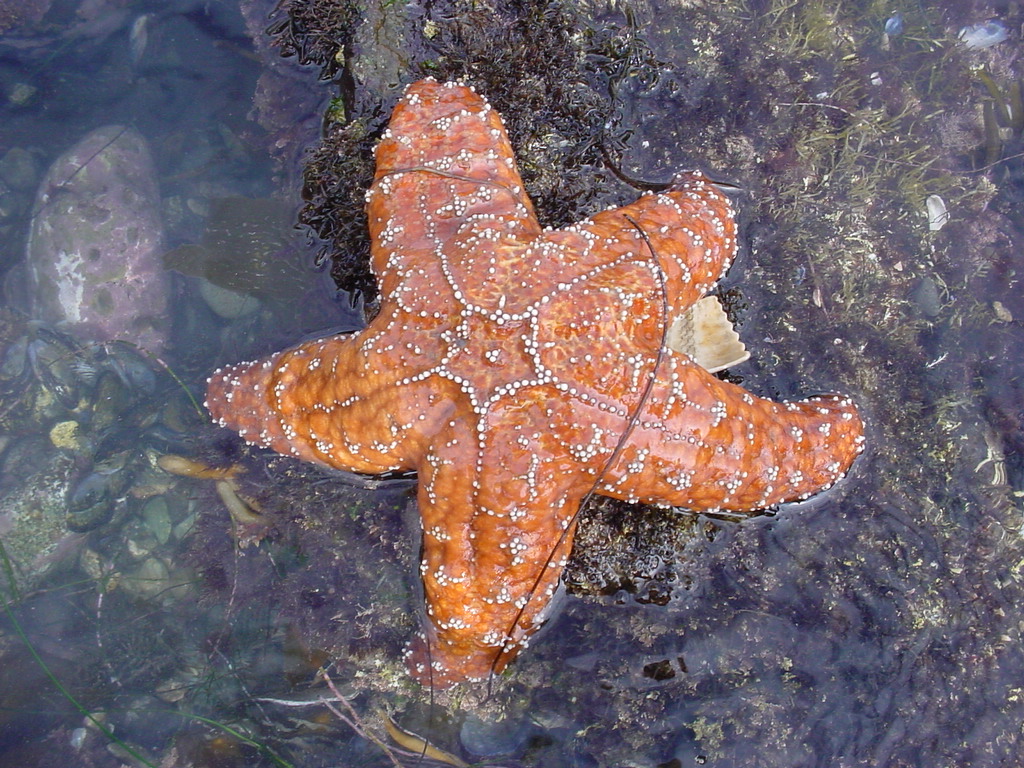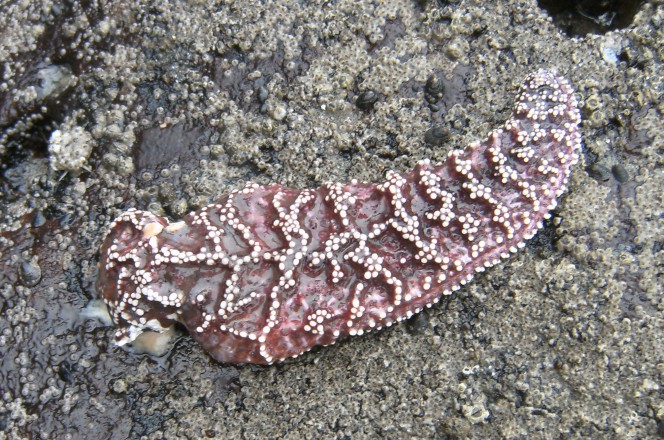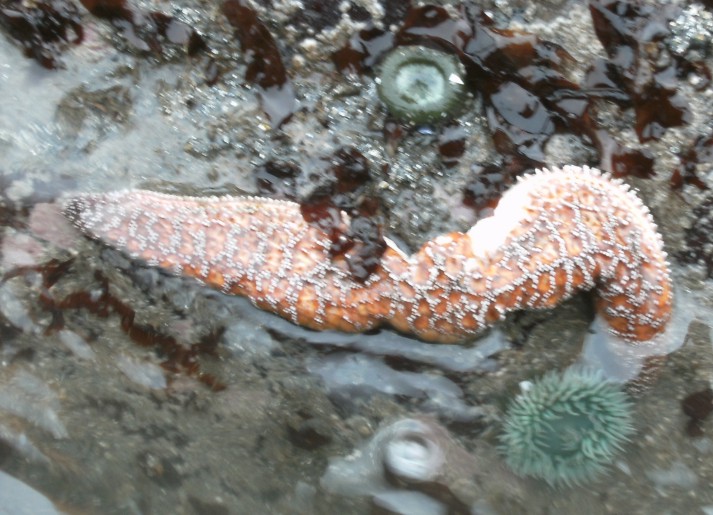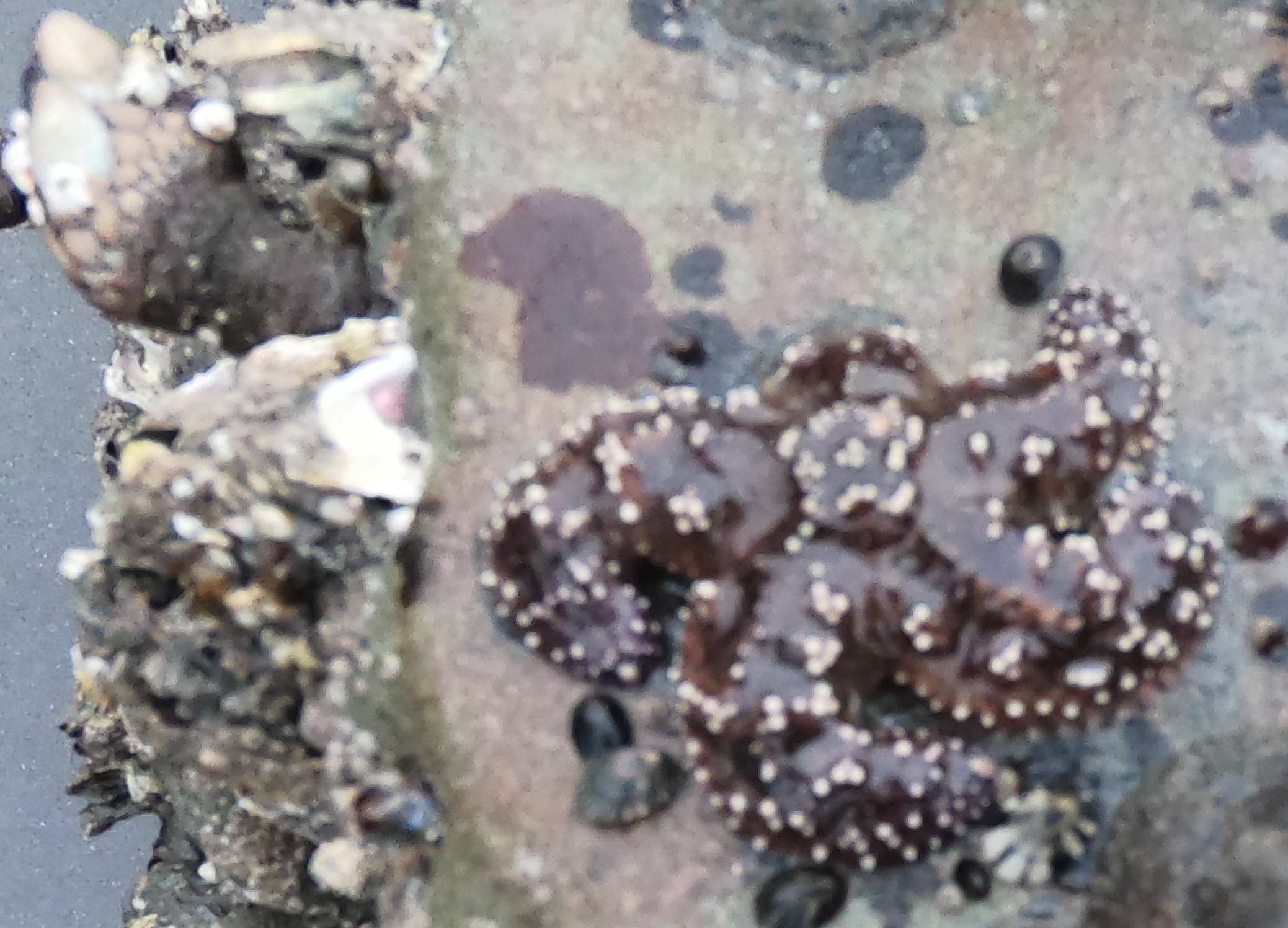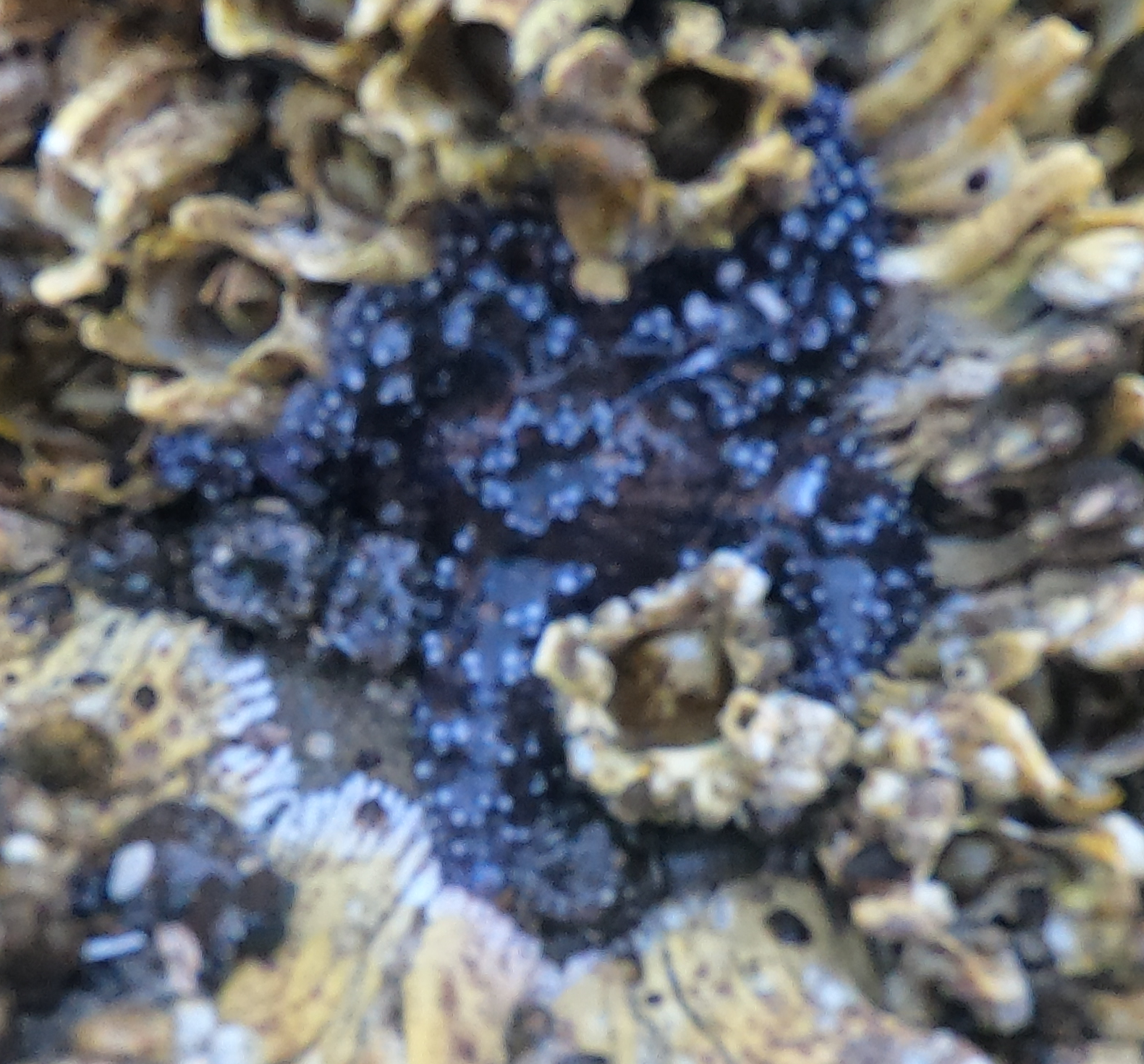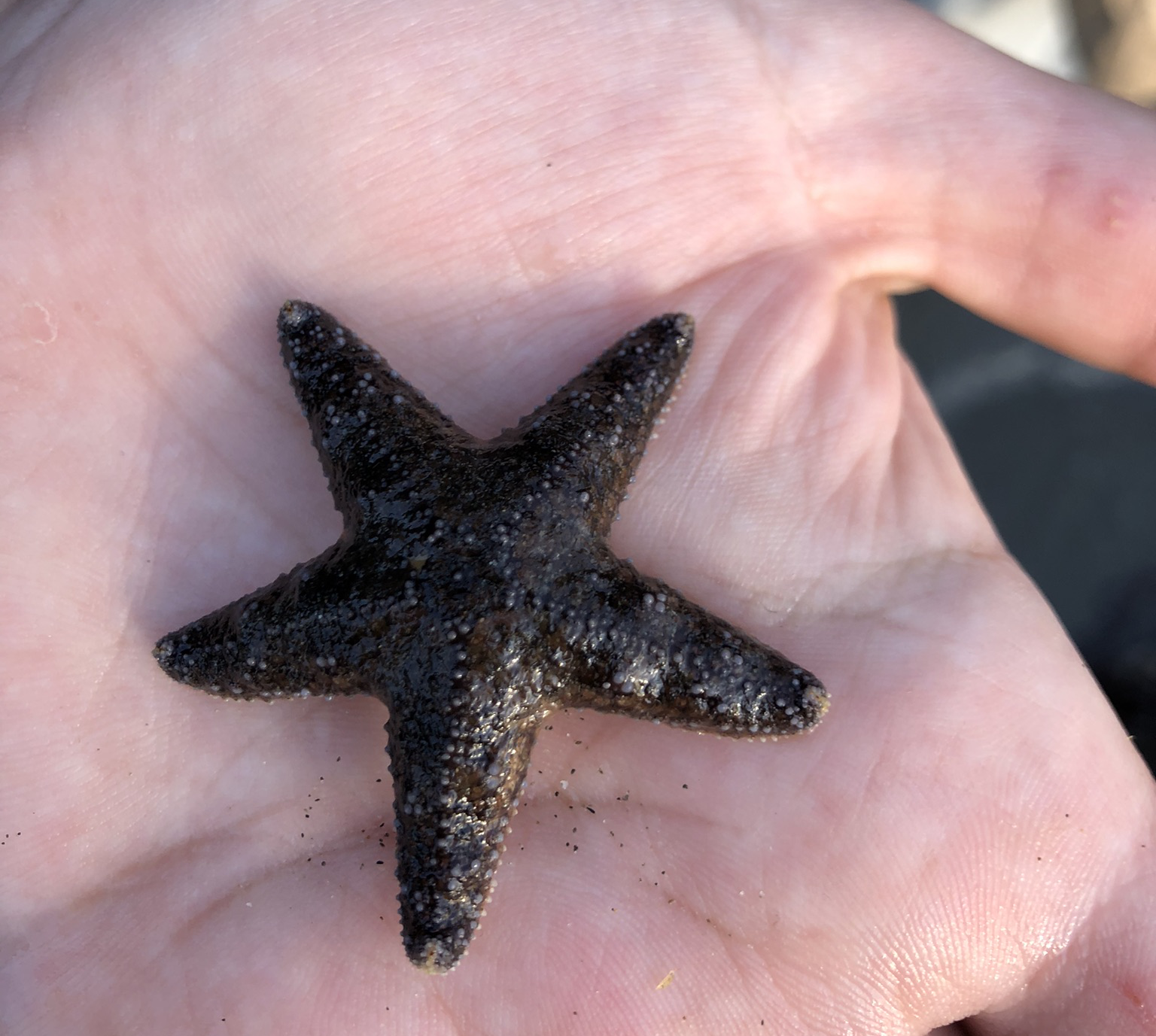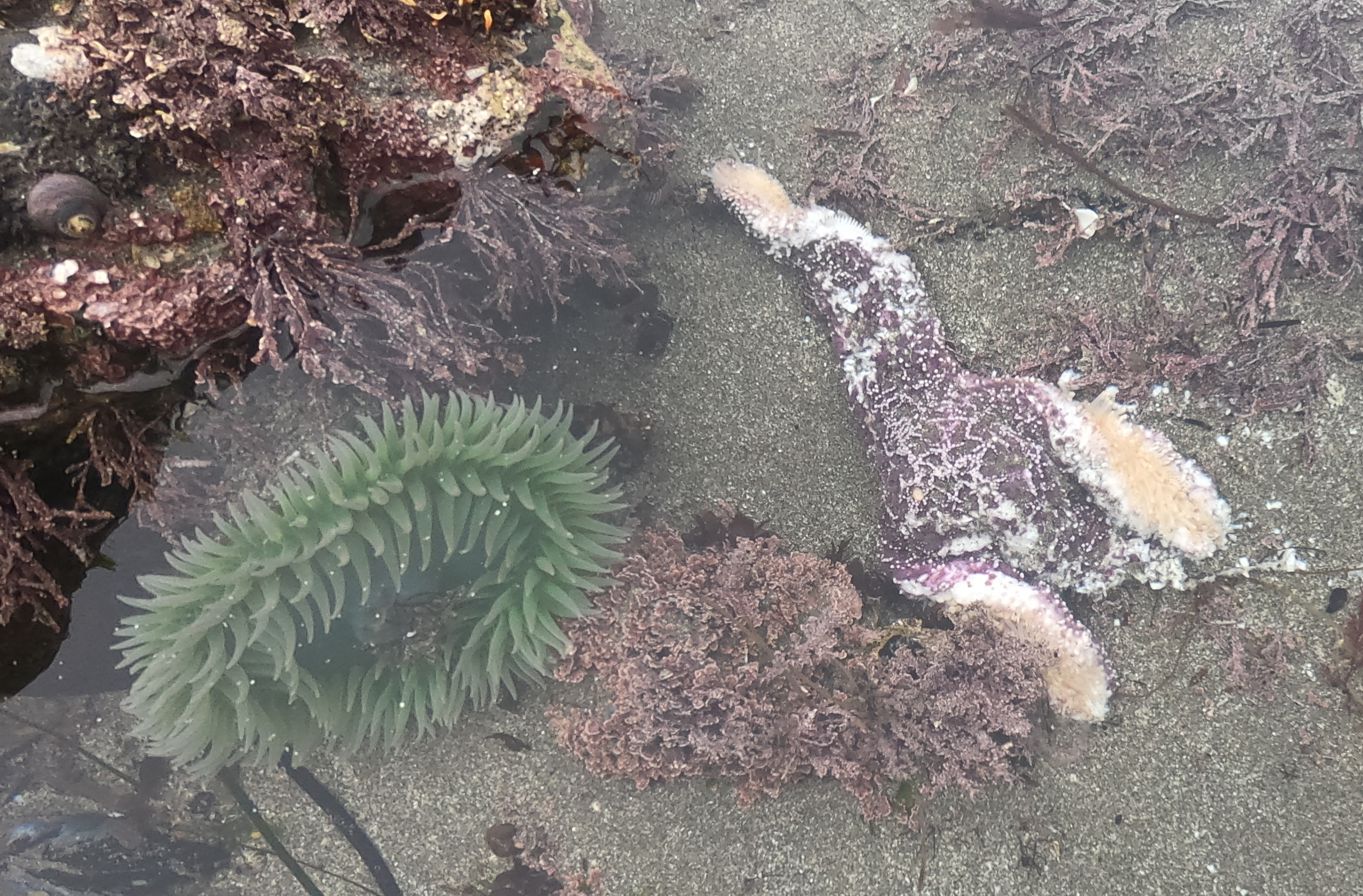Pisaster ochraceus (Brandt, 1835)Common Names: Ochre sea star, Purple sea star |
|
| Synonyms: None | 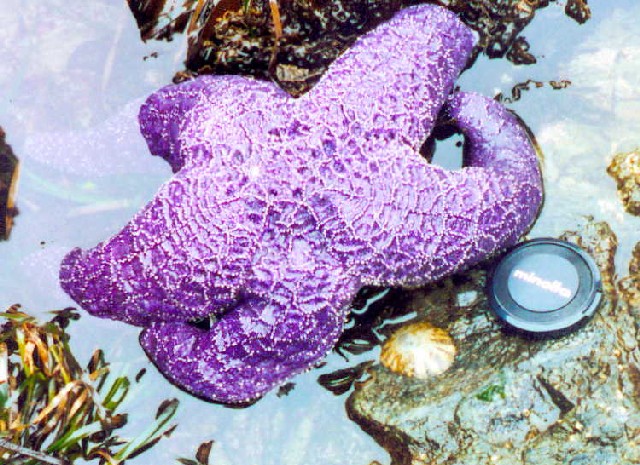 |
| Phylum Echinodermata
Class Asteroidea Order Forcipulatida Family Asteriidae |
|
| Individual found at Swirl Rocks, WA in the mid-intertidal zone. Top view, approximately 40 cm in diameter. | |
| Photo by: Melissa McFadden, June 2002. | |
How to Distinguish from Similar Species: Troschel’s Sea Star (Evasterias troschelii) may be confused with P. ochraceus at times. E. troschelii is distinguished from P. ochraceus by the smaller disk size and longer, tapering rays which are often thickest a short distance out from the base rather than at the base as in P. ochraceus; clusters of pedicellariae among the spines that border the ambulacral grooves, and the absence of a stellate pattern of spines on the aboral surface of the disk. There are two other, mostly subtidal, local species of Pisaster (Pisaster giganteus and Pisaster brevispinus) but they have different aboral spines and coloration which allows one to distinguish between the species.
Geographical Range: P. ochraceus occurs from Prince William Sound in Alaska to Point Sal in Santa Barbara Co., California.
Depth Range: P. ochraceus occurs in the low and middle intertidal zones, and sometimes in the subtidal zone (to 88 m).
Habitat: This organism occurs on wave-washed rocky shores. The juveniles are often found in crevices and under rocks.
Biology/Natural History: This species of seastar is often considered a keystone species in many intertidal regions. P. ochraceus feeds mainly on mussels (especially Mytilus californianus and Mytilus trossulus) or will also feed on barnacles, snails, limpets, and chitons when mussels are absent. P. ochraceus will insert its stomach into snail shells or slits as narrow as 0.1 mm between the shells of bivalves. Numerous species of mollusks have avoidance responses to the Ochre Sea Star, often involving moving away. Adult ochre seastars have few predators, but may be eaten by sea otters and sea gulls. P. ochraceus is more tolerant to air exposure than others in the Pisaster genus and regularly withstands up to 8 hours exposure during low tides. It is apparently unharmed by up to 50 hours of exposure in laboratory setting; but they have an inability to tolerate high water temperatures and low oxygen levels, keeping them out of shallow bays and high tidepools (See Pincebourde et al., 2008). Sexual reproduction occurs in the late spring or in the early summer. When ready to reproduce, mature gonads may account for up to 40 percent of the animal's weight. Spawning occurs in the Puget Sound around May to July. Fertilization occurs in the sea and development results in free-swimming, plankton-feeding larvae. Embryonic development and larval feeding have been studied in detail, however little is known of juvenile life following settlement and metamorphosis. P. ochraceus has been the focus of many major studies including tests on their digestive gland tissue (which is similar to cells in the mammalian pancreas and secretes materials similar to insulin).
Pisaster ochraceous is less water permeable than some other intertidal species such as Pycnopodia helianthoides. It makes extensive use of water intake through its madreporite to maintain internal fluid balance (Ferguson, 1994). The species is still highly susceptible to osmotic changes, however. Held and Harley (2009) studied populations from high and low salinity sites. Individuals from both populations were almost complete osmoconformers over the range of 15 to 30 psu. In both populations activity (as measured by the righting response) was lowest at the lowest salinity (15 psu), and the population which had been living at lower salinity did not have any better righting response than did the one living at high salinity. The population living at high salinity, however, did experience a higher mortality after exposure to 15 psu than did the other population. Feeding rates on mussels also varied with salinity, but the maximum feeding rate in the population living at low salinity was at a lower salinity than that of the population which lived at a higher salinity.
Seastar wasting disease is caused by the "Seastar associated densovirus" (SSaDV). During the seastar wasting disease that swept the US west coast in 2013-2015, a large proportion of the Pisaster ochraceus found along the coast died. In Oregon, the dieoff was most prominent in summer 2014 and 2015 but mortality persisted at low levels through the winter. Wasting was most higher in tidepools than on exposed rock surfaces. The major die-off was followed by an unusual increase (up to 300x) in recruitment by young seastars (Menge et al., 2016). In Burrard Inlet, BC, Canada, the relative abundance of this species declined in the intertidal while that of Evasterias troschelii increased after seastar wasting disease appeared in the area. It appears that both species are susceptible to wasting disease but E. troschelii is less susceptible (Kay et al., 2019)
Return to Main Page
References:
Dichotomous Keys:
Kozloff, 1987.
General References:
Kozloff, 1993.
Morris,
Abbott, and Haderlie, 1992.
Scientific Articles:
Burnaford, J., and M. Vasquez, 2008. Solar radiation plays a role in the habitat selection by the sea star Pisaster ochraceus. Marine Ecology Progress Series, 368: pp 177-187.
Cerny-Chipman, Elizabeth B., Jenna M. Sullivan, and Bruce A. Menge, 2017. Whelk predators exhibit limited population responses and community effects following disease-driven declines of the keystone predator Pisaster ochraceus. Marine Ecology Progress Series 570 pp 15-28.
Ferguson, John C., 1994. Madreporite inflow of seawater to maintain body fluids in five species of starfish. pp. 285-289 in Bruno David, Alain Guille, Jean-Pierre Feral, and Michel Roux (eds). Echinoderms through time. Balkema, Rotterdam.
Held, Mirjam B.E. and Christopher D.G. Harley, 2009. Responses to low salinity by the sea star Pisaster ochraceus from high- and low-salinity populations. Invertebrate Biology 128:4 381-390
Kay, S.W.C., A.M. Gehman, and C.D.G. Harley, 2019. Reciprocal abundance shifts of the intertidal sea stars, Evasterias troschelii and Pisaster ochraceus, following sea star wasting disease. Proceedings of the Royal Society Part B: Biological Sciences 286:1901 p doi: 10.1098/rspb.2018.2766
Knott, K. Emily, and Gregory A. Wray, 2000. Controversy
and consensus
in Asteroid systematics: new insights to Ordinal and Familial
relationships. American Zoologist 40:3 pp. 382-392
Menge, B.A., E.B. Cerny-Chipman, A. Johnson, J. Sullivan, S. Gravem, and F. Chan, 2016. Sea star wasting disease in the keystone predator Pisaster ochraceus in Oregon: insights into differential populations impacts, recovery, predation rate, and temperature effects from long-term research. PLoS One 11:5, May 4, 2016. doi: 10.1371/journal.pone.0153994 (Table 1 and the conclusion that orange seastars were more susceptible to wasting in the article was subject to a later correction in PLoS One, 2016, doi: 10.1371/journal.pone.0157302)
Miner,
C.M., J.L. Burnaford, R.F. Ambrose, L. Antrim, H. Bohlmann, C.A.
Blanchette, J.M. Engle, S.C. Fradkin, R. Gaddam, C.D.G. harley, B.G.
Miner, S.N. Murray, J.R. Smith, S.G. Whitaker, and P.T. Raimondi, 2018.
Large-scale impacts of sea star wasting disease (SSWD) on intertidal
sea stars and implications for recovery. PLoS One 13:3 doi:
10.137/journal.pone.0192870
Perumal, Viren, 2006. Responses to salinity of color polymorphs in two populations of the seastar Pisaster ochraceus. M.S. thesis, Loma Linda University Department of Earth and Biological Sciences.
Pincebourde, Sylvain, Eric Sanford, and Brian Helmuth, 2008. Body temperature during low tide alters the feeding performance of a top intertidal predator. Limnology and Oceanography 53(4): 1562-1573
General Notes and Observations: Locations, abundances, unusual behaviors, etc.:
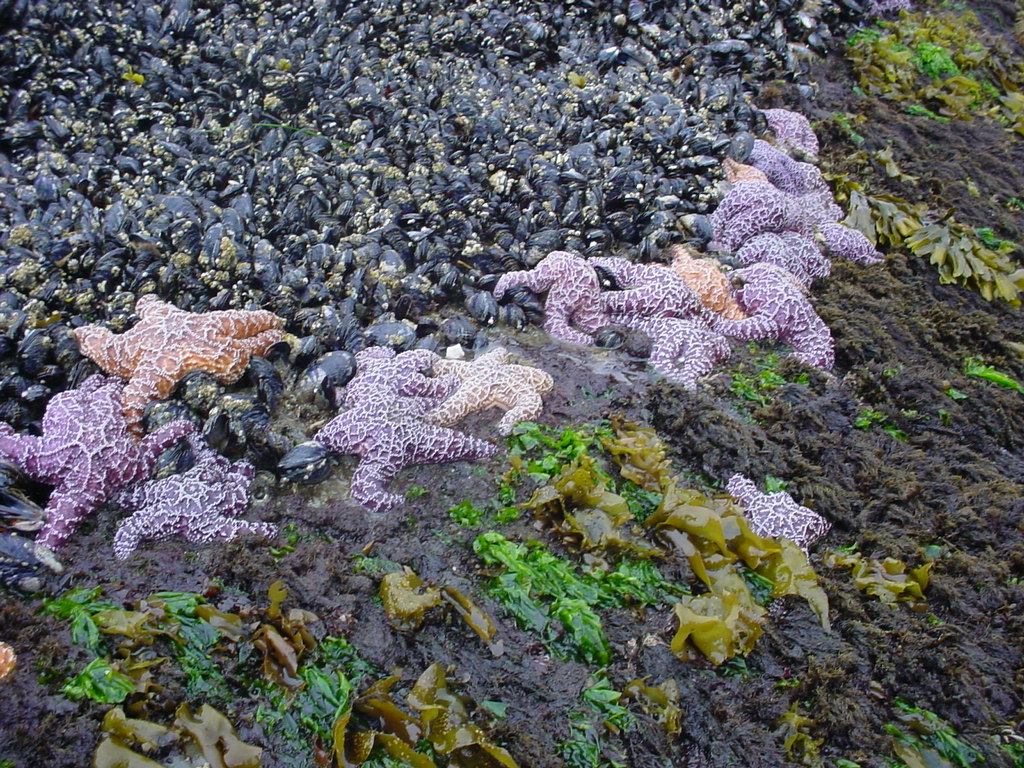
Pisaster ochraceus is a major predator of the
mussel
Mytilus
californianus in the intertidal zone.
Photo by Dave Cowles,
Goodman Creek, WA, July 2002
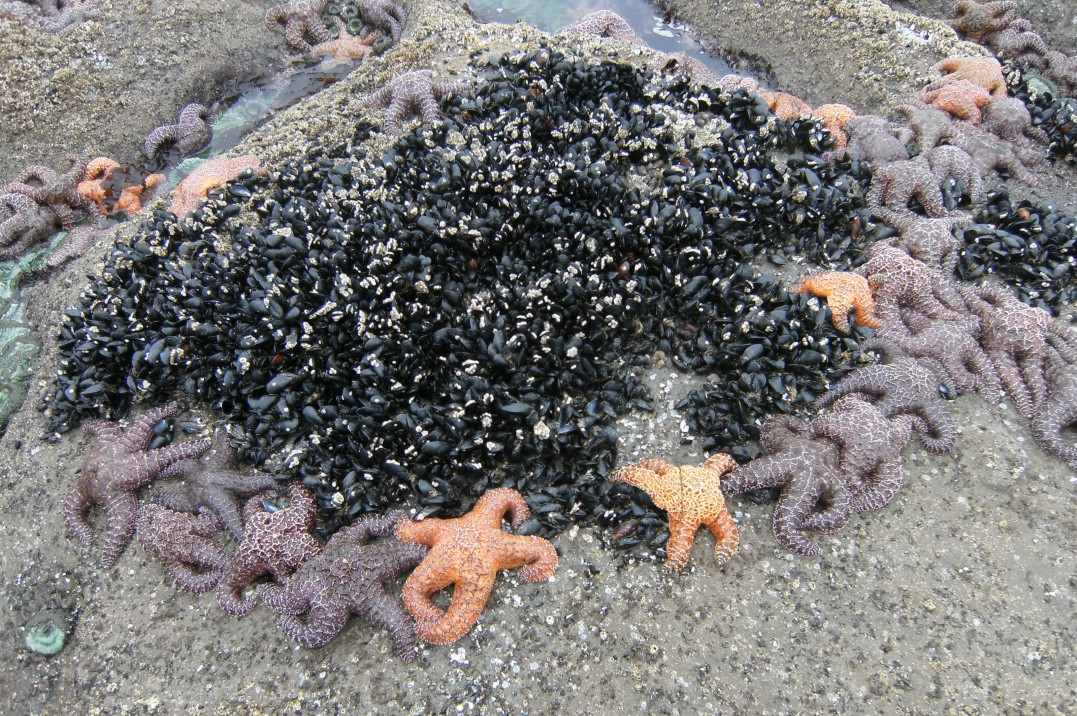
The seastars have surrounded this patch of Mytilus californianus on this nearly horizontal rock surface at Beach #4 and appear to be cleaning the rock entirely of mussels from the edges inward. Photo by Dave Cowles, July 2012
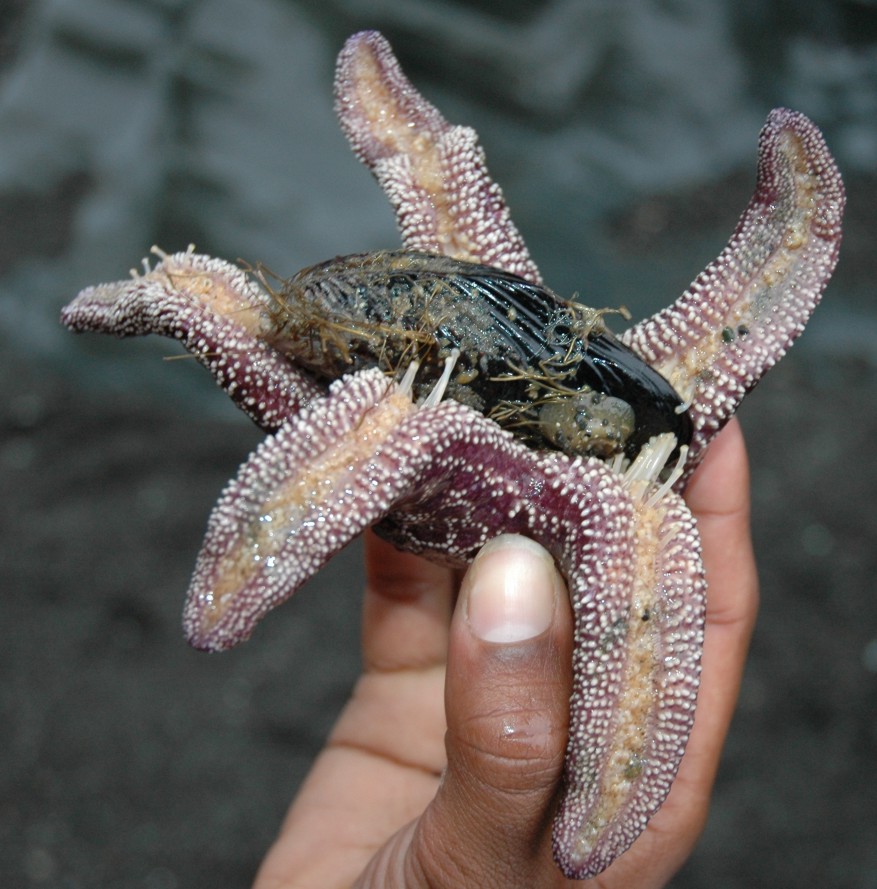
This individual is eating a mussel. Photo by Dave Cowles,
July
2006
The images above and below show some of the variations in the reticulate pattern of ossicles on the aboral surface. Photos by Dave Cowles at Dana Point, CA March 2005

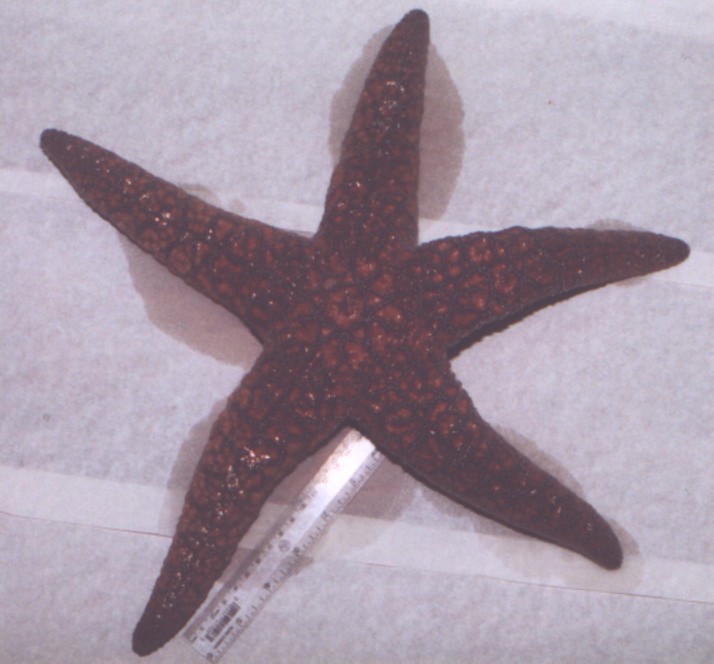
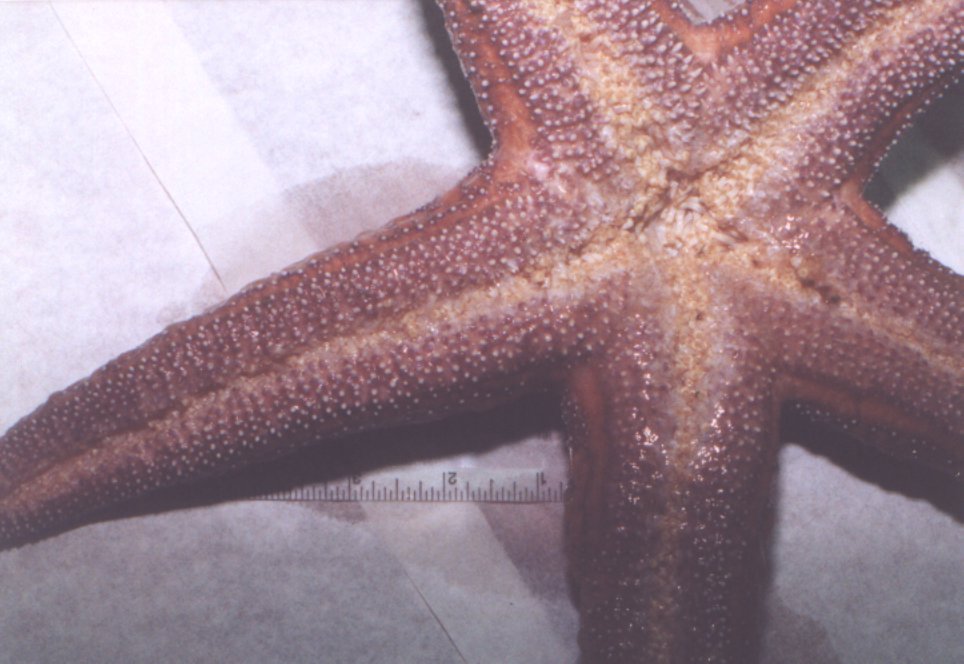
This is the underside (oral
side) of the individual above, showing the ossicles,
ambulacral
grooves,
and tube
feet.
The stomach is not everted.
Photo by Dave Cowles of an intertidal specimen from Sares Head, July
2001
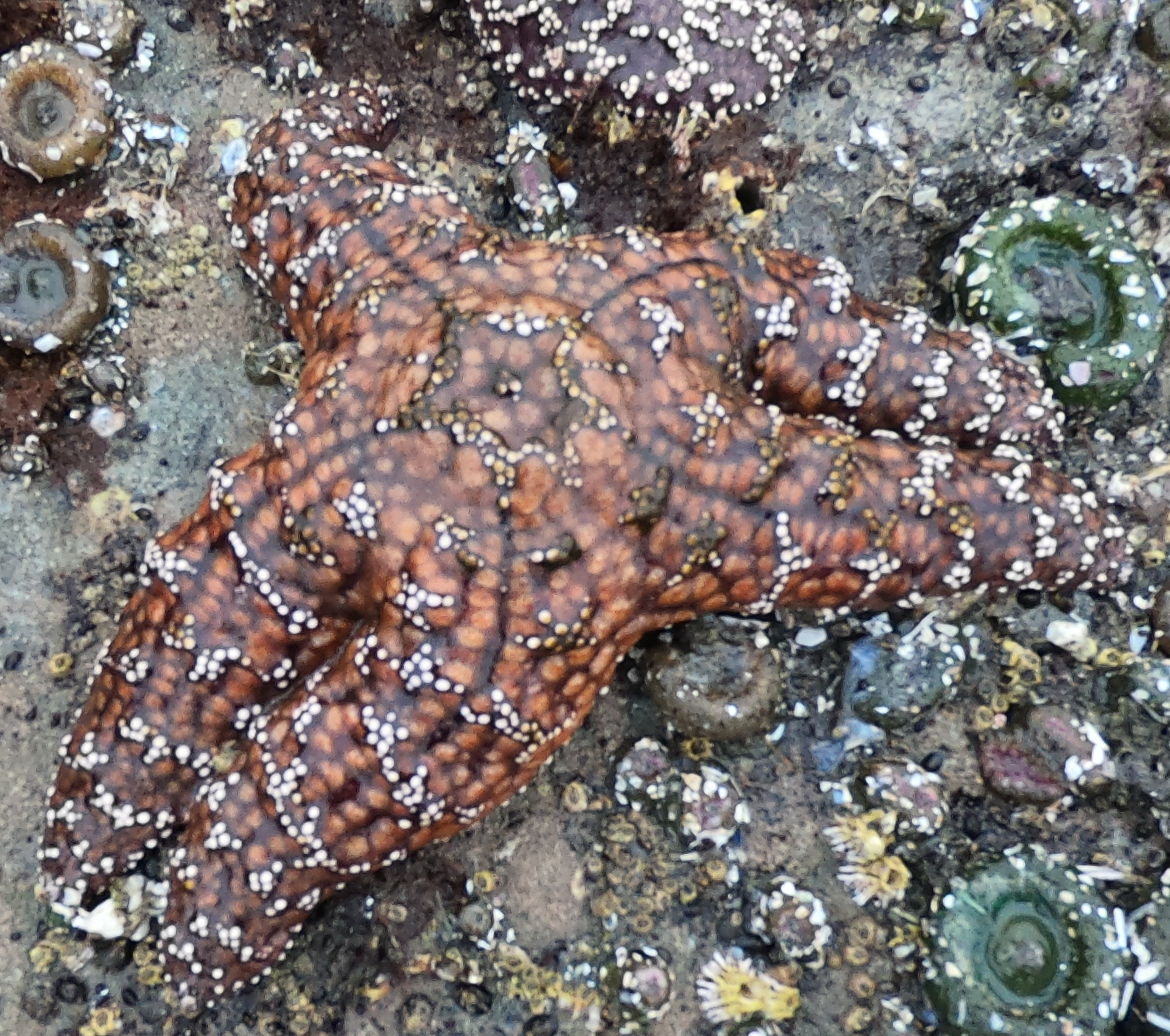 |
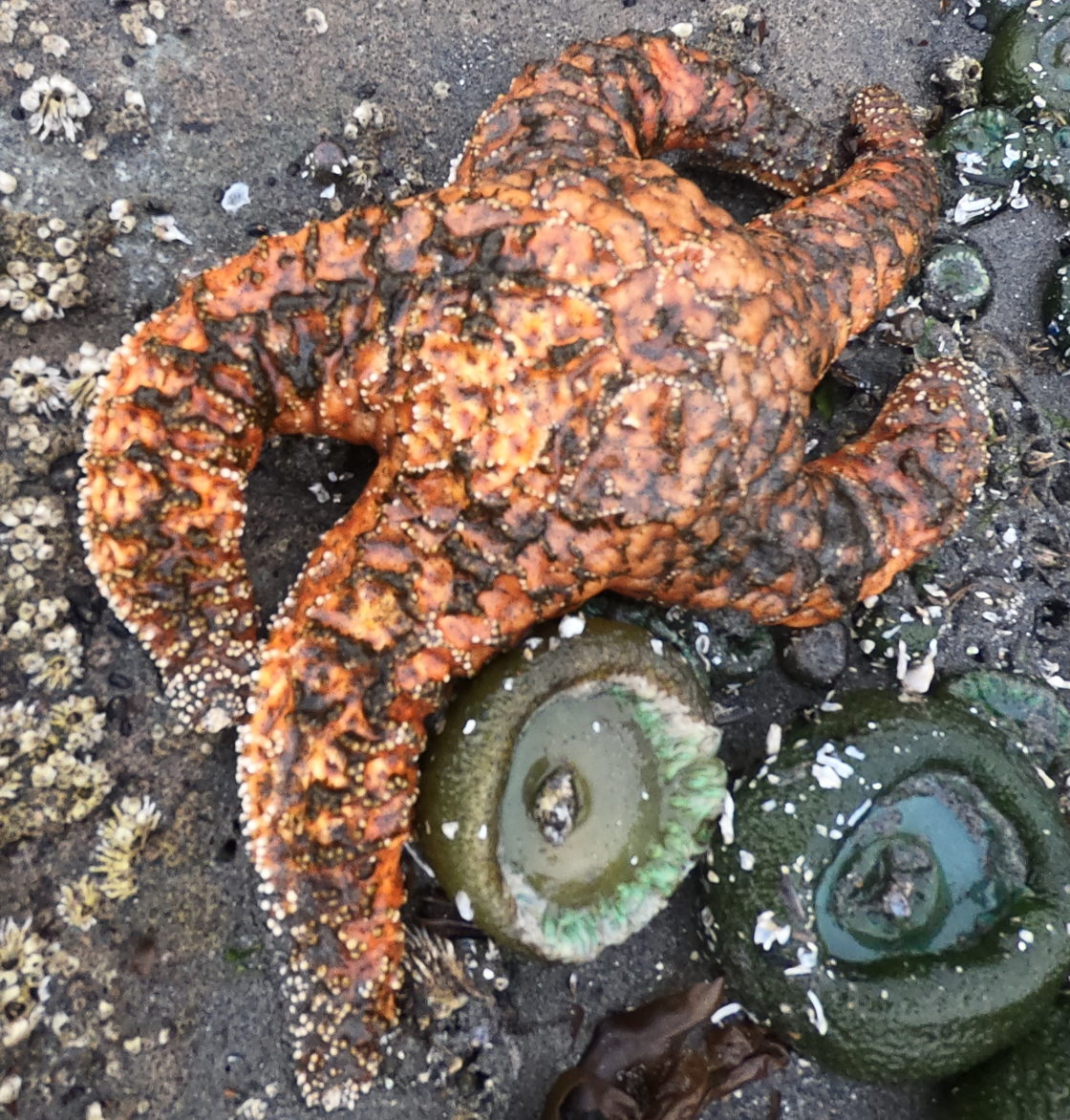 |
| Especially on the outer coast, some Pisaster ochraceus have oddball colors such as these. Photos by Dave Cowles | |
2006: Viren Perumal is studying metabolism of the various color phases of Pisaster ochraceus as a function of salinity for his MS research. We have noted that a number of the seastars brought into the lab during late June and July have shed gametes. They always seem to shed in the evening or at night. Click here to see a movie of Pisaster ochraceous shedding eggs, and here to see one shedding sperm.

This closeup of the aboral
surface shows the extended papulae
or coelomic pouches, used for respiration and waste excretion, which
are
often extended when seastars such as P. ochraceus
are underwater.
The papulae
give the
seastar's surface a soft, fuzzy apperance.
Photo July 2007 by Kirt Onthank.

This individual on the north side of a large, fairly isolated rock
at Shi Shi beach is dying (see how the central disk and inner ray
tissue
are white and sloughing off and one ray has fallen entirely
off).
I could find no mussels and hardly any large barnacles on this rock so
perhaps the seastar has starved to death. Seastars on other,
nearby
rocks which had mussels were in good condition. Photo by Dave
Cowles,
July 2008
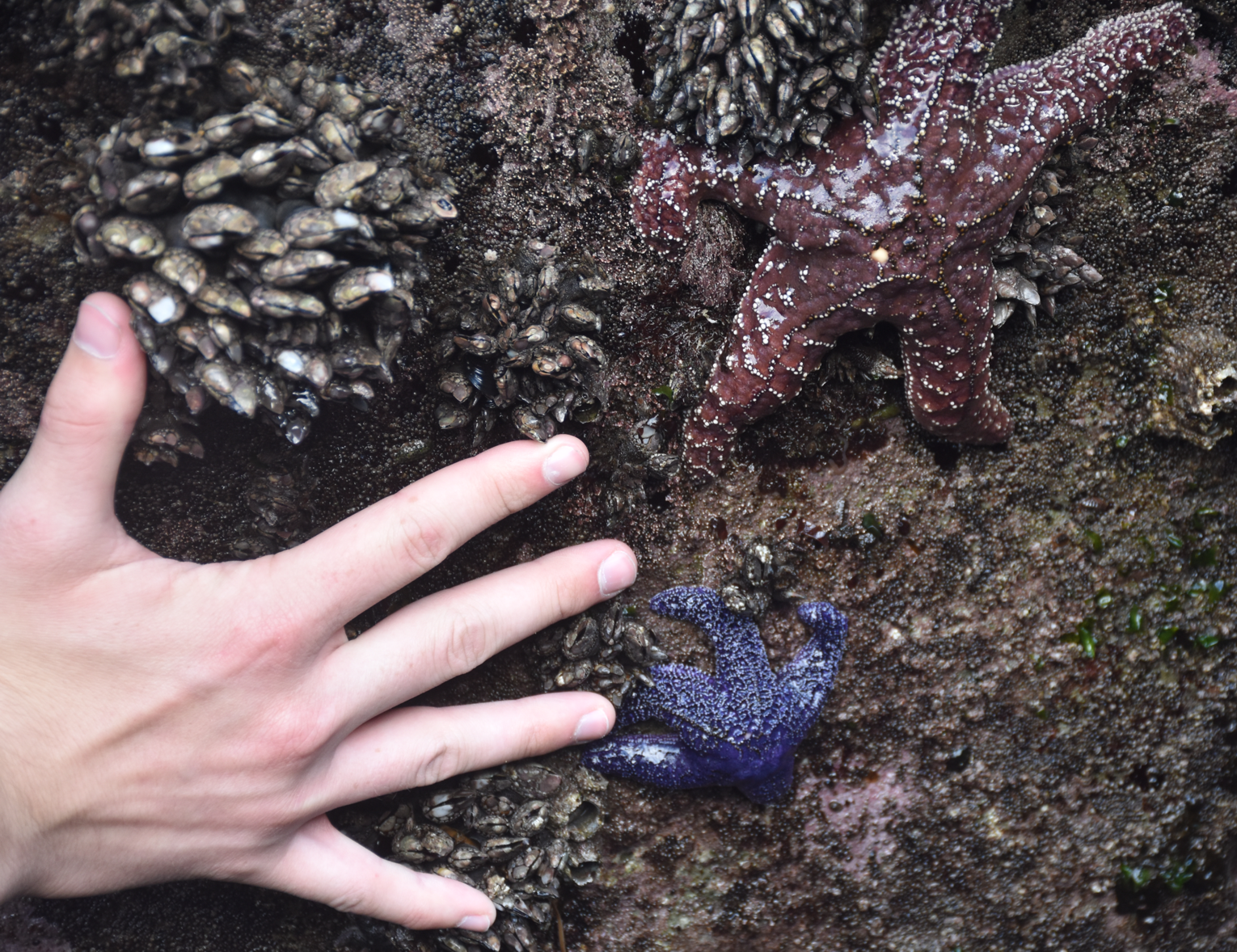
In 2021 we found few if any of the seastars at Rialto Beach with wasting disease, but did find this little feller--new growth! Photo by Dave Cowles, July 2021
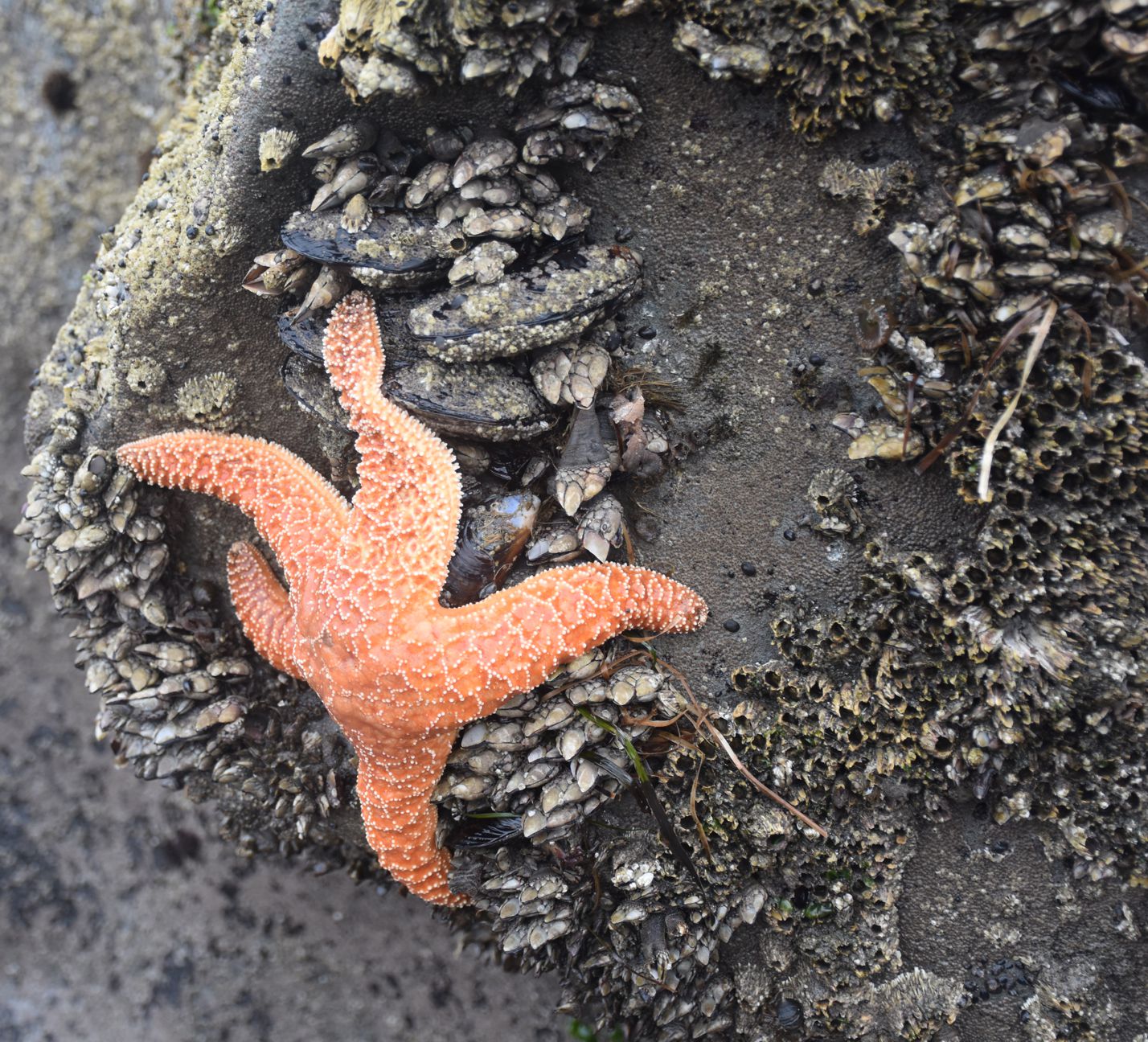
This seastar is enjoying a leisurely breakfast of mussels at Kalaloch Beach #4. Photo by Dave Cowles, July 2019
Authors and Editors of Page:
Melissa McFadden (2002): Created original page
Edited by Hans Helmstetler 12-2002; Dave Cowles 2005, 2008
